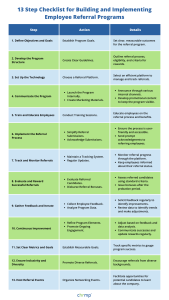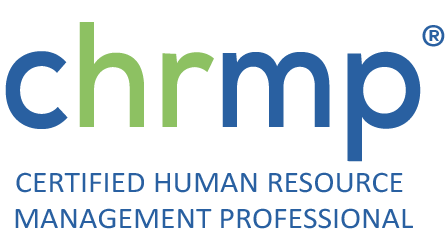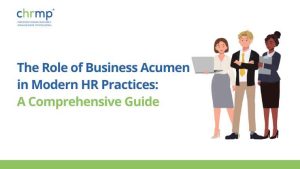In today’s competitive job market, finding and attracting top talent is more challenging than ever. Employee referral programs streamline the hiring process and foster a sense of involvement and ownership among existing employees. This guide aims to provide HR professionals with a comprehensive understanding of employee referral programs and practical steps to implement them effectively.
Thank you for reading this post, don't forget to subscribe!Table of Contents
ToggleKey Components of Employee Referral Programs
1. Referral Bonus Program
A referral bonus program is a critical component of successful employee referral programs. Offering monetary or non-monetary rewards to employees who successfully refer candidates encourages participation and boosts engagement. These bonuses can range from cash rewards, gift cards, or extra vacation days to more creative perks such as exclusive experiences or donations to a charity of the employee’s choice. Establishing a clear and attractive referral bonus program helps motivate employees to actively participate in the recruitment process.
2. Employee Referral Policy
A well-defined employee referral policy is essential for clarity and fairness. This policy outlines the procedures for submitting referrals, eligibility criteria for participation, and the specific conditions under which referral bonuses will be awarded. The policy should be easily accessible to all employees and include details such as the types of positions eligible for referrals, the timeline for bonus payouts, and any restrictions (e.g., not eligible for senior management positions). A transparent employee referral policy ensures that all employees understand the process and feel confident in their participation.
3. Employee Referral Scheme
The employee referral scheme refers to the structured approach used to manage and track referrals. This includes the technology or platforms used to submit referrals, track their status, and communicate updates to both the referring employee and the HR team. Utilizing an efficient system, such as an online portal or integrated HR software, ensures that referrals are handled promptly and accurately. This structure not only simplifies the process for employees but also allows HR to monitor the program’s effectiveness and make necessary adjustments.
4. Internal Referral Program
Encouraging employees to refer candidates for internal job openings is another vital aspect of employee referral programs. An internal referral program focuses on filling positions from within the organization, promoting career growth and development among current employees. This program highlights the company’s commitment to internal mobility and helps retain top talent by providing them with new opportunities for advancement. By prioritizing internal referrals, companies can create a culture of growth and loyalty.
5. Associate Referral Program
Extending referral programs to associates, partners, and even alumni can significantly expand the pool of potential candidates. An associate referral program includes individuals who are not direct employees but have a strong connection to the organization, such as contractors, vendors, and former employees. By leveraging these extended networks, companies can access a diverse and extensive talent pool. This program also demonstrates the value placed on the broader community associated with the organization, fostering stronger relationships and goodwill.
Benefits of Employee Referral Programs
Implementing an employee referral program can address several challenges HR professionals face in the recruitment process. Here are the detailed benefits of employee referral programs and how they help overcome common HR obstacles:
1. Cost Efficiency
One of the primary challenges HR departments face is the high cost associated with traditional recruitment methods, such as advertising on job boards, using recruitment agencies, and conducting extensive interview processes. Employee referral programs can significantly reduce these costs. By leveraging the existing network of employees, companies can minimize spending on external recruitment services. Additionally, the cost of referral bonuses often pales in comparison to the expenses incurred through traditional hiring methods.
For example, if a company typically spends $10,000 on agency fees to fill a position, offering a $2,000 referral bonus instead represents substantial savings. These cost savings can then be reinvested into other HR initiatives or employee development programs.
2. Faster Hiring
The lengthy time-to-fill metric is a common pain point for HR professionals. Traditional hiring processes can take months, leading to prolonged vacancies and increased workload for existing staff. Employee referral programs expedite this process by tapping into a pool of candidates who are already pre-screened by current employees. Since these candidates are often familiar with the company through their referrers, they tend to move more quickly through the hiring pipeline.
For instance, an employee might refer a former colleague who is actively seeking new opportunities. Because the referred candidate is already vouched for and likely aligns with the company’s culture, the time spent on preliminary screenings and interviews is reduced, leading to quicker hires.
3. Higher Quality of Hires
Another significant challenge is ensuring the quality of new hires. Employee referral programs often yield higher-quality candidates because current employees have a good understanding of the company’s culture and job requirements. They are likely to refer individuals who they believe are a good fit, both in terms of skills and cultural alignment.
For example, an employee refers a highly skilled friend from their professional network who has a proven track record in the industry. This friend not only has the necessary technical skills but also shares similar values and work ethics, leading to a smoother integration and higher performance.
4. Improved Employee Retention
High turnover rates can be detrimental to an organization, leading to increased recruitment costs and lost productivity. Referred employees typically have higher retention rates because they come with a built-in support system. They are often more committed to the company, knowing they were recommended by someone they trust.
For example, a new hire who was referred by a close friend within the company is more likely to stay longer due to the existing relationship and the ease of having someone to turn to for guidance and support. This built-in support network helps them adapt more quickly and feel more integrated into the company culture, reducing the likelihood of early departure.
5. Enhanced Employee Engagement
Employee engagement is crucial for maintaining a motivated and productive workforce. Employee referral programs increase engagement by involving employees in the recruitment process and recognizing their contributions. When employees are given the opportunity to influence who they work with, it fosters a sense of ownership and pride in the company’s success.
For instance, an employee who successfully refers a candidate and sees them excel in their role feels a sense of achievement and connection to the company’s growth. This positive reinforcement can lead to higher job satisfaction and overall engagement.
6. Strengthened Company Culture
Maintaining a strong and cohesive company culture is a common challenge, especially in growing organizations. Employee referral programs help strengthen culture by bringing in new hires who are likely to share the same values and work ethic as existing employees. This cultural alignment can result in a more harmonious and collaborative work environment.
For example, if a company values teamwork and collaboration, employees will likely refer candidates who exhibit these traits. As a result, the referred hires seamlessly blend into the company culture, reinforcing the desired values and behaviors.
7. Increased Employee Morale
Recognizing and rewarding employees for their referrals can boost morale and job satisfaction. Referral bonuses and recognition programs show employees that their efforts are valued and appreciated, contributing to a positive work environment.
For instance, an employee who receives a referral bonus for successfully recommending a new hire feels acknowledged for their contribution. This recognition not only motivates them to participate in the referral program again but also enhances their overall morale and loyalty to the company.
8. Broader Talent Pool
One of the challenges HR departments face is reaching a diverse and qualified talent pool. Employee referral programs can broaden the talent pool by tapping into employees’ networks, which often include individuals from various backgrounds and experiences. This diversity can lead to more innovative ideas and solutions within the organization.
For example, an employee who is part of a professional association may refer a colleague from a different industry or background, bringing fresh perspectives and skills to the company. This diversity can enhance problem-solving capabilities and drive innovation.
9. Simplified Onboarding
Onboarding new hires can be a complex and time-consuming process. Referred employees typically have an easier onboarding experience because they already have a connection within the company who can help them navigate the initial stages of their employment. This connection can provide informal guidance and support, making the transition smoother.
For instance, a new hire who was referred by a friend can rely on that friend to answer questions and offer insights about the company’s processes and culture, reducing the learning curve and speeding up the onboarding process.
Understanding Employee Referral Programs Beyond the Recruitment Process
Beyond addressing recruitment challenges, employee referral programs offer a range of additional benefits that can significantly impact various aspects of human resource management. These benefits enhance the overall HR strategy, contributing to the efficiency and effectiveness of HR operations.
1. Enhanced Employer Branding
Employee referral programs can positively influence the company’s reputation and employer brand. When employees actively participate in the referral process, they are essentially endorsing the company as a great place to work. This endorsement can extend beyond the organization and attract high-quality candidates who are influenced by the positive word-of-mouth from current employees.
For example, employees sharing their positive experiences on social media or professional networks about successfully referring friends or colleagues can enhance the company’s image as an attractive employer. This organic promotion can lead to increased interest from potential candidates who trust the recommendations of their peers.
2. Improved Employee Relationships
Encouraging employees to participate in referral programs can foster stronger relationships among staff. When employees refer candidates from their personal networks, they are more likely to support and mentor the new hires. This mentorship and support can lead to stronger team cohesion and collaboration.
For instance, an employee who refers a former colleague might take an active role in helping them settle into the new job. This collaboration can enhance interpersonal relationships and create a more supportive and unified workplace environment.
3. Boost in Employee Motivation and Productivity
Recognizing and rewarding employees for successful referrals can have a motivational impact. Employees feel valued and appreciated when their efforts in referring qualified candidates are acknowledged. This recognition can lead to increased motivation and productivity.
For example, an employee who receives a referral bonus or public recognition for bringing in a new hire may feel a sense of accomplishment and motivation to continue contributing positively to the company. This boost in morale can translate to higher productivity and engagement levels.
4. Strategic Workforce Planning
Employee referral programs provide HR professionals with valuable data and insights that can inform strategic workforce planning. By analyzing referral trends, HR can identify which roles are most frequently referred and understand the skills and qualities that employees value in their referrals.
For instance, if a particular department consistently generates successful referrals, HR can examine the factors contributing to this success and apply these insights to other departments. This strategic approach can help HR plan for future hiring needs and align recruitment efforts with the company’s long-term goals.
5. Reduction in Onboarding and Training Costs
Referred candidates often require less extensive onboarding and training compared to those hired through traditional methods. This is because referred candidates typically have a better understanding of the company’s culture and expectations through their referrer. This familiarity can lead to a quicker adaptation period and reduced training costs.
For example, a referred candidate who already has insight into the company’s workflow and culture through their referrer can hit the ground running, requiring less time and resources to become fully productive. This efficiency in onboarding can free up HR resources to focus on other strategic initiatives.
6. Support for Diversity and Inclusion Initiatives
Employee referral programs can support diversity and inclusion efforts by encouraging employees to refer candidates from diverse backgrounds. HR can design referral programs to promote diversity by offering incentives for referrals that contribute to a more inclusive workforce.
For instance, HR can implement targeted referral campaigns that highlight the importance of diversity and encourage employees to refer candidates from underrepresented groups. This proactive approach can help build a more diverse and inclusive workplace, aligning with the company’s diversity goals.
7. Enhanced Data and Analytics
Employee referral programs provide HR with a wealth of data that can be used for analytics and continuous improvement. By tracking the success rates, retention, and performance of referred candidates, HR can gain insights into the effectiveness of the referral program and make data-driven decisions.
For example, HR can analyze the performance metrics of referred hires versus non-referred hires to determine the impact of the referral program on employee success. This data can be used to refine the program, optimize referral bonuses, and improve overall hiring strategies.
13 Step Checklist for Building and Implementing Employee Referral Programs
Creating and implementing an effective employee referral program involves careful planning, clear communication, and continuous evaluation. Here’s a detailed checklist, including additional steps and details beyond those found in the reference article.
1. Define Objectives and Goals
Establish Program Goals: Determine the specific outcomes desired, such as reducing time-to-hire, increasing the quality of hires, or boosting employee engagement.
Example: Aim to have 30% of new hires come from employee referrals within the first year.
2. Develop the Program Structure
Create Clear Guidelines: Draft a detailed employee referral policy outlining the referral process, eligibility, and criteria for rewards.
Example: Include specific roles eligible for referral bonuses, timelines for payouts, and any restrictions (e.g., management positions may not be eligible).
Design the Referral Bonus Program: Decide on attractive rewards that will motivate employees to participate.
Example: Offer monetary bonuses ranging from $500 to $5,000 depending on the position’s level and difficulty to fill, or non-monetary rewards such as extra vacation days or event tickets.
3. Set Up the Technology
Choose a Referral Platform: Select a user-friendly platform to manage and track referrals efficiently.
Example: Use an integrated HR software solution that allows employees to submit referrals easily and provides real-time updates on their status.
4. Communicate the Program
Launch the Program Internally: Announce the program through various channels, such as emails, intranet, and company meetings.
Example: Host a launch event to explain the program details and encourage participation.
Create Marketing Materials: Develop promotional content to keep the program visible.
Example: Use posters, digital content, and success stories to highlight the benefits and successes of the referral program.
5. Train and Educate Employees
Conduct Training Sessions: Organize workshops or training sessions to educate employees about the referral process and program benefits.
Example: Provide detailed guides and FAQs to help employees understand how to submit referrals and track their progress.
6. Implement the Referral Process
Simplify Referral Submissions: Ensure the referral process is easy and accessible.
Example: Use an online form where employees can input the referral’s details and attach their resume.
Acknowledge Submissions: Send immediate acknowledgments to employees who submit referrals.
Example: Use automated email responses to confirm receipt and provide information on the next steps.
7. Track and Monitor Referrals
Maintain a Tracking System: Use the referral platform to monitor the progress of each referral.
Example: Create a dashboard that displays key metrics such as the number of referrals, conversion rates, and time-to-hire for referred candidates.
Regular Updates: Keep referring employees informed about the status of their referrals.
Example: Send periodic emails or notifications to update employees on the status of their referrals.
8. Evaluate and Reward Successful Referrals
Evaluate Referred Candidates: Assess referred candidates using the same criteria as other applicants.
Example: Conduct standard interviews and assessments to evaluate the referred candidate’s fit for the position.
Disburse Referral Bonuses: Issue the referral bonus once the referred candidate completes a specified probationary period.
Example: Pay out the referral bonus after the new hire has successfully completed three months with the company.
9. Gather Feedback and Iterate
Collect Employee Feedback: Regularly solicit feedback from employees to identify areas for improvement.
Example: Conduct surveys or hold focus groups to gather insights on what works well and what could be enhanced.
Analyze Program Data: Review data collected from the referral platform to identify trends and make necessary adjustments.
Example: Analyze metrics like the quality of hires, retention rates, and overall employee participation in the program.
10. Continuous Improvement
Refine Program Elements: Make adjustments to the program based on feedback and data analysis.
Example: Simplify the referral process if employees find it too complicated, or provide additional training if needed.
Promote Ongoing Engagement: Keep the program active by regularly communicating successes, updating rewards, and recognizing top referrers.
Example: Feature top referrers in company communications, celebrate successful hires, and periodically refresh the incentives.
Additional Steps and Considerations
11. Set Clear Metrics and Goals
Establish Measurable Goals: Set specific, measurable objectives to track the success of the referral program.
Example: Track metrics such as the number of referrals, time-to-hire, cost-per-hire, and employee retention rates.
12. Ensure Inclusivity and Diversity
Promote Diverse Referrals: Encourage employees to refer candidates from diverse backgrounds to foster an inclusive workplace.
Example: Offer higher referral bonuses for referring candidates from underrepresented groups.
13. Host Referral Events
Organize Networking Events: Host events to facilitate referrals and provide opportunities for potential candidates to learn about the company.
Example: Arrange casual meet-and-greet events where employees can bring their referrals to meet hiring managers.
Conclusion
Building and implementing a successful employee referral program involves careful planning, clear communication, and continuous evaluation. By following this detailed checklist, HR professionals can create a robust program that leverages employee networks, enhances recruitment efforts, and fosters a more engaged and motivated workforce. Implementing these steps ensures the program is well-received, effectively managed, and continuously improved to meet the evolving needs of the organization.

Examples from the Industry
Innovative employee referral programs are becoming essential tools for companies seeking to enhance their recruitment strategies. Here are some notable examples from around the globe that illustrate how organizations are creatively leveraging these programs.
KPMG’s Global Employee Referral Program
KPMG has developed a comprehensive global employee referral program called “Connections.” This initiative allows employees to refer candidates for positions not only in their local offices but also across various countries where KPMG operates. The process is streamlined, requiring employees to submit basic information about the referred candidate and their own KPMG connection. This global approach not only broadens the talent pool but also fosters a sense of community among employees as they help shape the workforce across borders.
Fiverr’s Gamification Approach
Fiverr has taken a unique route by incorporating gamification into its employee referral program. By partnering with Zao, Fiverr tracks social job sharing and awards points for various referral-related actions. Employees can compete on a leaderboard, with top performers receiving gifts quarterly and annually. This competitive element not only motivates employees to participate but also enhances engagement by making the referral process fun and interactive.
Google’s Targeted Referral Questions
At Google, the referral process is simplified through targeted questioning. Recruiters ask employees specific questions, such as “Who’s the best software developer you know in Boston?” This method encourages employees to think critically about their networks and identify high-quality candidates, thereby improving the likelihood of successful hires. This straightforward approach highlights the importance of clarity in the referral process.
Accenture’s Charitable Twist
Accenture has innovated its referral program by allowing employees to donate a portion of their referral bonuses to a charity of their choice. This not only fosters a sense of altruism among employees but also enhances their emotional connection to the company. By matching the donation, Accenture effectively motivates employees to refer candidates while contributing to social causes, creating a win-win scenario for both the company and the community.
Intel’s Diversity Incentives
Intel has implemented a strategy to promote diversity in hiring by doubling the referral bonus for employees who successfully refer women and minorities. This initiative not only encourages a more diverse workforce but also aligns with broader corporate social responsibility goals. By incentivizing diversity, Intel demonstrates a commitment to creating an inclusive workplace while also enhancing the quality of hires through employee referrals.
Best Practices for Effective Referral Programs
To create a successful employee referral program, companies should consider the following best practices:
- Attractive Incentives: Offer compelling rewards to motivate employees to participate actively.
- Simplicity and Transparency: Ensure the referral process is straightforward and that employees receive regular updates on the status of their referrals.
- Recognition: Acknowledge and celebrate employees who refer candidates, regardless of the outcome, to foster a culture of appreciation and engagement.
By adopting these innovative strategies and practices, organizations can significantly enhance their employee referral programs, leading to better hiring outcomes and a more engaged workforce.





